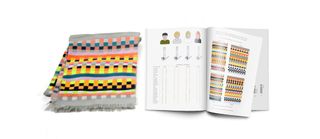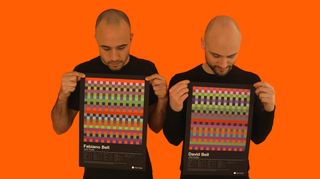
Wear Your Genes: Scarves Turn Your DNA Into Unique Pattern

You can now buy scarves featuring designs based on your unique DNA sequence, making these items among the most personalized gifts ever made.
London-based company Dot One notes that each person shares about 50 percent of his or her DNA with bananas, 90 percent with mice and 99.9 percent with the other 7.3 billion humans on Earth. This leaves 0.1 percent of the genome to distinguish one person from another. Dot One, named after this 0.1 percent, seeks to highlight what makes everybody unique, with DNA-personalized items such as scarves and prints.
To create the patterns on the garments, Dot One has customers swab their cheeks to collect DNA samples. This swab is then sent to AlphaBiolabs, the United Kingdom's leading accredited provider of DNA testing. The lab uses polymerase chain reaction (PCR), a technique that creates many copies of DNA, to analyze the sample. [Gifts for Geeks 2015: Fun Gift Ideas for Him or Her]
"DNA testing is no longer confined to the lab and is making its way into the consumer environment, yet there are still a lot of reservations from people fearful of decoding their own genetic language," said Dot One founder Iona Inglesby. "Customers are not used to doing an at-home DNA test as part of their retail experience, and Dot One, as a design company, is introducing this personalization method in a fun and engaging way. This process in the future may apply to how they are prescribed precision medicine from their general practitioner, use home diagnostic kits to track inherited diseases or even find a compatible partner using a DNA dating app."
The lab investigates specific locations in human chromosomes where genetic differences are known to occur, focusing on DNA variations known as short tandem repeats (STRs).
DNA is composed of strands of molecules known as nucleotides, which come in four varieties, labeled A, T, C and G. STRs are sequences of DNA normally two to five nucleotides long, which are repeated a varied number of times, depending on the individual, usually from five to 36.
For instance, at location D7S280 on chromosome 7, repeats of the sequence "GATA" occur. Individuals may have six to 15 repeats of GATA at this location. One pattern of STRs might lead to a string of red and blue squares on a scarf, while a different pattern might yield a string of green and pink squares. The colors "mirror the fluorescent dyes used in the process of DNA sequencing itself," Inglesby told Live Science.
Sign up for the Live Science daily newsletter now
Get the world’s most fascinating discoveries delivered straight to your inbox.

Dot One focuses on 23 different STRs across several chromosomes. The fingerprint from these STRs is enough to distinguish any one person from everyone else on Earth, the company said.
"Genetics is absolutely fascinating. However, it is something which is hard to grasp — enormous in theory and yet microscopic in practice," Inglesby said. "For something fundamental to life, I think it is as a topic quite hard for nonscientists to relate to. By building a narrative around the data and creating something tactical and tangible with it, it is more engaging."
Inglesby came up with the idea for DNA-personalized items while studying design at the Royal College of Art in London, "working on a project with a Scottish weaving company who had a huge catalogue of tartan fabrics," she said. "I was interested in how each Scottish family had a material affiliated to their name, and yet when I asked about the reason for the colors and patterns of the tartans, there was no meaning behind them. I wanted to create a material that intrinsically represented a family, and so decided to explore the idea of using genetics as a language to code the weaving pattern, creating a sort of 'DNA tartan.'" [Code of Life: Photos of DNA Structures]
As Inglesby researched how to translate DNA into something weavable, "during a synthetic biology workshop at Imperial College London, I learnt that scientists were testing DNA as a storage device for binary data," she said. Industrial weaving was also once controlled by systems of binary data — specifically, by punch cards, pieces of paper with patterns of holes punched in them that encoded instructions for controlling machinery. "So I knew there was a link between these coded languages," Inglesby said.
There's also an element of surprise with Dot One's products, she said.
"I think it's exciting that the customer doesn't actually know what their product will look like," Inglesby said. "It is their genetics that determine the aesthetics, so it's a bit of a surprise. The most interesting part is when we get people of the same family testing, so we can map similarities between siblings and which parts of the genetic code have been inherited from parent to child."
The products from Dot One are not cheap. A scarf costs 310 British pounds, or about $460 U.S. dollars, while a print costs 139 British pounds, or about $205 U.S. dollars. For anyone willing to pony up the cash, the company does ship internationally. (More information on how to purchase DNA-personalized products can be found on Dot One's website.)
"Part of the future vision for Dot One is to establish links with health care organizations and donate a percentage of profits to the research of inherited genetic diseases and family counseling," Inglesby said.
Follow Live Science @livescience, Facebook & Google+. Original article on Live Science.

Most Popular


